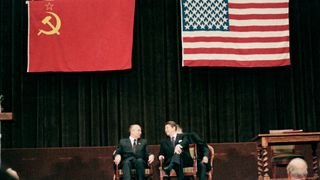In May of 1945, the Third Reich was in chaos. Adolf Hitler was dead, German surrender was imminent, and Allied troops had already begun divvying up German territory. But high-ranking Nazi engineer Wernher von Braun wasn’t worried. In fact, he approached the US government directly— informing them of his location and waiting calmly for their arrival. As the brain behind the world’s first long-range ballistic missile, von Braun knew his expertise made him a highly valuable military asset. And sure enough, his so-called captors gave him a decidedly warm welcome.
Von Braun wasn't the only Nazi scientist receiving this treatment. While World War II was almost over, a new war was brewing. And the US was eager to recruit the smartest minds in Germany before the Soviets got the chance. This became known as Operation Paperclip— a clandestine campaign that brought over 1,500 German scientists to the US between 1945 and 1962. The program was named for the paperclips attached to the files of early recruits— indicating that incriminating information like Nazi affiliations or suspected war crimes could be disregarded.
Von Braun, for example, had overseen an SS project that relied on forced labor from thousands of concentration camp prisoners. While von Braun approached the US directly, other scientists had to be identified and located. One important asset in this effort was a Nazi-compiled list of Germany’s top scientists, which someone had unsuccessfully tried to dispose of by flushing down a toilet. But the US was just one player in this scramble. The Soviets were also competing to seize German brainpower, resorting to bribery and forced relocation. The French and British lacked the money to lure the best German brains, but that didn't stop them from kidnapping the occasional scientist.
They also stole patents and dismantled factories to learn what they could. The US approach, however, featured a different and particularly tempting brand of coercion: the promise to relocate entire German families and grant them citizenship. This controversial offer was one of the reasons Paperclip was initially shrouded in secrecy. But the project became difficult to hide when Germans started popping up all over the US. The military tried to get ahead of any controversy by revealing the operation to the press in late 1946. But the news immediately attracted criticism from many prominent voices, including Albert Einstein, Eleanor Roosevelt, and the NAACP, as well as many veteran’s organizations.
These parties opposed granting German scientists citizenship while millions of displaced persons, including survivors of Nazi atrocities, had no chance of coming to America. Most Americans were also against employing former Nazis in sensitive national security positions. But as the Cold War ramped up, the military argument for keeping these scientists out of Soviet hands overpowered popular objections. With his Nazi past largely hidden from the public, von Braun became one of the US’s most important engineers at the height of the Space Race.
In 1958, his team responded to the Soviet launch of Sputnik with the US’s own successful satellite launch. And in the 60s, he was the chief architect of Saturn V, the rocket that brought Americans to the moon. Other Paperclip recruits contributed to the development of chemical weapons such as Agent Orange, pharmaceutical research, and the development of modern airplanes. These contributions helped the US government present Paperclip as a success. But, in hindsight, it’s hard to gauge how helpful the program really was. While von Braun saved the US years of rocketry experimentation, there's no reason to think American scientists couldn't have developed the same technology without him. Furthermore, very few Paperclippers were as exceptional as von Braun. Many were average scientists who either completed their contracts and returned to Germany, or took jobs alongside Americans with equivalent expertise. But ultimately, the issue of Paperclip’s success is just one of many questions raised by its contentious approach to science, ethics, and national security.
Can scientists working on military technology be apolitical, or are they responsible for their creations? Can pressing political and military concerns justify overlooking war crimes? In many ways, von Braun’s obituary sums up the operation’s murkiness “A kind of Faustian shadow may be discerned in the fascinating career of Wernher von Braun a man so possessed of intellectual hunger, that any accommodation may be justified.”
THANKS YOU
Your readership is a gift that fuels my passion for writing. Thank you for investing your time and attention in my blog. Your support inspires me to keep sharing and creating.

Find me on :
This is my participation post for Initiative:MAYINLEO
Posted Using InLeo Alpha



Congratulations @krish.kumar! You have completed the following achievement on the Hive blockchain And have been rewarded with New badge(s)
Your next target is to reach 70 posts.
You can view your badges on your board and compare yourself to others in the Ranking
If you no longer want to receive notifications, reply to this comment with the word
STOPCheck out our last posts:
thanks a lot guys
Keep up the fantastic work @krish.kumar! Your dedication and hard work will pay off when you reach your target.
thanks